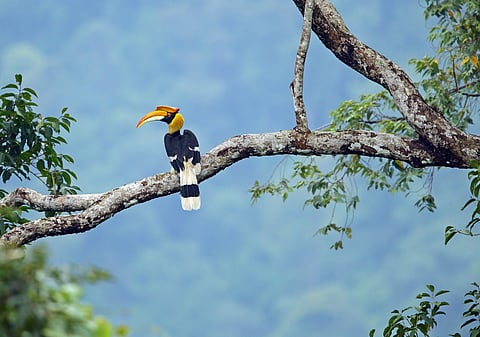
- Destinations
- Experiences
- Stay
- What's new
- Celebrating People
- Responsible Tourism
- CampaignsCampaigns
- Subscribe
- Buy Now

Birdwatching can be a rare pleasure—and that intensifies manifold when one is walking the forests of Bodoland. Bodoland is a treasure trove of national parks, sanctuaries and protected areas rich in a variety and number of birds. Travellers have the choice of either look for rare and elusive birds, or enjoy the everyday, common species. Either way, Bodoland assures a marvellous time.
One of the birding hotspots of the world, Manas National Park boasts an astounding 450 species of birds. Indeed, just a morning's outing could have birdwatchers ticking off over a 100, even perhaps 200 avian species. The list might run into several pages, but Manas National Park is especially famous for sheltering the largest population of the Bengal Florican (Houbaropsis bengalensis). This is a kind of Bustard listed as "critically endangered" on the IUCN (International Union for Conservation of Nature) Red List.
Sprawled over 500 sq km in Chirang and Baksa districts of the Bodoland Territorial Region, this protected area has the distinction of being a Wildlife Sanctuary, National Park, Biosphere Hotspot, a UNESCO Natural World Heritage Site, a Project Tiger as well as a Project Elephant reserve.
Bengal floricans live in open tall grassland habitats with scattered bushes, which is one of the two major biomes present in Manas. The birds are most easily spotted in the breeding season from March to August, usually in the early mornings and evenings. In the mating season between March and May, the birds indulge in an elaborate courtship display, in which the male shows off his black and white plumage in short arching flights and choreographed strutting, with fluffed up neck feathers and head pumping to attract females. The object of all his affection, the dull coloured female, is less likely to be seen, well-hidden in tall sugarcane grass.
A new era of peace and stability has been ushered in this region by the signing of the Bodo Peace Accord in 2020. This historic agreement between the Centre, the Assam government and the Bodo groups, ensures support for the conservation of forests and the natural heritage of Bodoland. With more stability in place, the rich biodiversity of Bodoland is sure to attract nature and wildlife enthusiasts from across the world.
A particularly magnificent corner of Bodoland, Chakrashila Wildlife Sanctuary has a record of 119 bird species, including a large presence of aquatic birds. Among possible sightings are the Black Francolin, Jungle Bush Quail, Lesser Whistling Duck, Cinnamon Bittern, Red-Necked Falcon, Red-Headed Vulture and Greater Spotted Eagle as well as the more common Indian Pond Heron, Cattle Egret, Purple Heron and Bronze-Winged Jacana. Notified in 1994, Chakrasila Wildlife Sanctuary is the second habitat designated to protect the endangered Golden Langur. Spread over two districts, Kokrajhar and Dhubri, the sanctuary is ringed by hills and is famous for the twin lakes of Dheer and Diplai, havens for any bird watcher.
Sprawled over 422 sq km, Raimona National Park has about 170 species of birds. Situated in the Kokrajhar district, this is a lush forested area, and harbours a vast variety of wildlife, and is known for its legendary elephant herds and huge butterfly population. In fact, the area is recognised as an Important Bird and Biodiversity Area (IBA) by Birdlife International. It is easy to stumble upon a Sultan Tit in the woods or a Red Breasted Parakeet, so those binoculars need to be kept handy
Bornadi Wildlife Sanctuary is spread across 26.21 sq km along the foothills of the Indo-Bhutan border, in Udalguri district. Gaining its name from the river Bornadi that flows through this protected area, this is a scenic backdrop for sightings of the White-Capped Redstart, Blue Magpie, White-Winged Wood Duck, plenty of Kingfishers and Woodpeckers apart from the ubiquitous Peafowl and Hornbills.
In a world full of adventurous possibilities, undoubtedly the traveller is spoilt for choice. For the extremely driven, there are mountains to climb, streams to ford, remote corners of the earth to reach. That is not for everyone, though. For those who prefer to simply be outdoors amidst nature, walk along a few trodden and untrodden paths, feeling the morning sun warm on their backs as they amble without a set goal in mind, then the soft adventure of birding is for them.
When birding, it is customary to wear dull clothing that blends with the surroundings. Greys, browns, dark greens or camouflage are best.
When out in the wild, please take care to speak in low tones.
When photographing birds or other fauna, be careful not to advance too close and disturb the animals.
Taking pictures of nests up close is discouraged by all birding organisations as it harms the newborn as parents may desert the nest as a result of human scent or fear.
The best binoculars for birding are 10x50, 8x40 or 7x35, the first being magnification and the second number representing diameter of the lens in millimetres.
